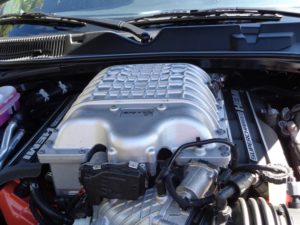
Showing up in my neighborhood recently was Dodge’s Hellcat, America’s most powerful muscle car.
The 2017 Challenger SRT Hellcat coupe, which performs with 707 horsepower, highlighted the weekend.
Seeking a relatively quiet roadway for the ‘Cat, Jan and I drove out to Stoneham on a Saturday evening for dinner at Dewey’s Bar and Grill. That was the only direction that would steer us away from the busy, congested traffic of the Front Range.
From the time we hit Colo. 14 at Briggsdale and along the 40 miles eastward to Stoneham, few cars were traveling either direction. We passe

d only four cars, and no one passed us.
In custom, sport or track mode, tested on our run to Stoneham, the Dodge with a full accelerator depression will jump from 65 miles per hour to 100 in barely more than a blink or two of an eye.
These performance capabilities are countered with the largest front brakes ever offered in a vehicle produced by Fiat Chrysler Automobiles – 15.4-inch Brembo rotors and six-piston calipers (red in color). Stopping power from high speeds is impressively secure.
To reach the 707-hp level, the 6.2-liter Hemi Hellcat V-8 is supercharged and linked to a TorqueFlite 8-speed automatic transmission with manual mode and paddle shifters.
In a return to more heavily traveled highways, Jan and I drove to Parker Sunday morning to meet our newest great-grandson, Brooks, born to Kara and Daniel Hansen.

The rear-wheel-drive Challenger coupe is the second Hellcat I’ve driven. Two years ago, it was the 2015 Dodge Charger SRT Hellcat, a four-door sedan, that came my way. It boasted the same 707-hp engine, while offering smoother ride, more comfort and roominess.
The Challenger Hellcat isn’t sold for comfort, though, and it is a blast to drive. The Challenger’s performance-tuned suspension, lending outstanding handling at higher speeds, includes SLA (short-long arm) front setup, upper A arm, coil springs, stabilizer bar and lateral and diagonal lower links. At the rear are five-link independent suspension, with coil springs, gas-charged monotube shocks (like the front), stabilizer bar and isolated suspension cradle. It rides on Pirelli PZero 275/40ZR20 tires.
The Hellcat came with two key pods, one red and the other black. The red key allows use of full power in the Dodge, including tuned steering, shifting and suspension. It permits launch-control starts from rpm levels of 1800 to 3500. The SRT Hellcat will clip off the 0 to 60 sprint in 3.5 seconds, and is rated at top speed of 184 miles per hour.
With the black key, the Challenger operates only in Eco mode, which means rpm level is lowered and starts are in 2nd gear. Even at that lower output, though, the Hellcat performs with amazing power. The lowered rpm cuts horsepower to something around 500.
The Hellcat, even in its destroyer gray exterior finish, draws attention wherever it is driven. On startup, the roar is muscle-car-level at its greatest.
A $62,495 base price for the Challenger SRT Hellcat jumps to $71,790 with the supercharged package, the transmission upgrades, a power sunroof and dual carbon stripes on the hood. It also includes UConnect navigation, integrated voice command with Bluetooth, 16-speaker Harman Kardon sound system with subwoofer in trunk, Apple CarPlay capability, backup camera, heated and cooled leather seats, blind-spot and rear cross-path detection.
And when the power runs are concluded, SRT individual performance pages will be displayed at the push of a button.
The Challenger Hellcat weighs in around 4,500 pounds on a wheelbase of 116 inches; it is larger than its chief rivals, the Chevy Camaro and Ford Mustang.